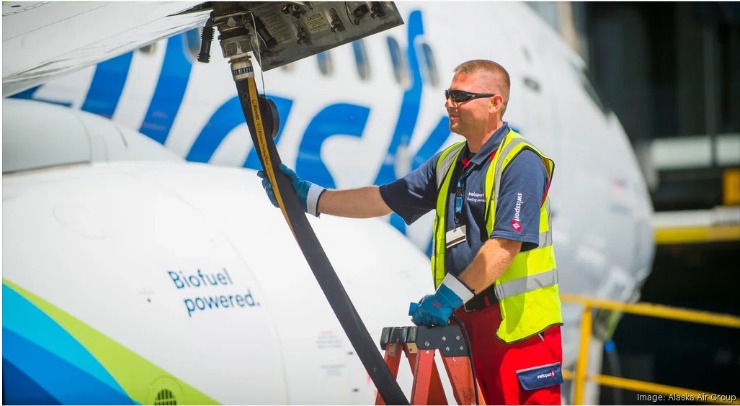Listen to this article 6 min
Sustainable aviation fuels are reaching an inflection point in Washington state, with mounting public and private sector investments to encourage large-scale production.
Airline users have snapped up every drop of SAF they could get their hands on in recent years, but it still only accounts for a tiny fraction of the total jet fuel demand. That’s put a sense of urgency behind establishing large-scale production – including interest from oil and gas developers in sites around Washington state – to bring costs down.
With a vote in the House April 14, a bill to subsidize aviation biofuel projects passed both chambers of the state legislature nearly unanimously. That follows major new projects in March by SeaTac-based Alaska Air Group (NYSE: ALK) and Snohomish County that aim to clear hurdles and develop new resources for the industry.
The bill, SB 5447, would provide tax incentives for producers and wholesalers of biofuels, as well as credits for airline consumers and other measures to support their adoption. It aims to help aviation compete for the expensive biofuels against industries like trucking where the margins are much more competitive, and government mandates have spurred wider adoption.
“Policies like these start to create a level playing field,” said John Plaza, CEO and chief investment officer of SkyNRG North America. On-road vehicles are “clearly on the path to electrification. Aviation doesn’t have the same luxury … the industry truly needs SAF to be able to meet its climate reduction goals.”
Of the technologies being proposed to reduce carbon emissions, SAF is the “most promising energy source” for aviation in the near term, former Boeing Co. CEO Phil Condit told the Business Journal earlier this year. He outlined the challenges with battery weight and energy density for hydrogen and electric propulsion, which make them much more adaptable for ground transportation.
SAF is made using materials like municipal waste or agriculture and timber byproducts that would otherwise go to landfills, reducing emissions by up to 80% over traditional fossil fuels. Airlines have touted the fuels as critical near-term tools to reach their carbon reduction targets, and the White House has issued a challenge to produce enough SAF to meet 100% of U.S. jet fuel demand by 2050, which it has estimated will be around 35 billion gallons per year.
Studies by Washington State University and the Port of Seattle have identified sufficient raw materials in the region to support the industry. With available “feedstocks” and production technologies, policy has been the limiting factor, Plaza said.
The credits will be performance-based, requiring a minimum amount of carbon reduction, and increasing along with the efficacy of the fuels.
“(The bill) doesn’t pick technologies, it doesn’t pick winners and losers,” Plaza said. “It’s goals-focused, so we don’t choose a technology or feedstock that may be irrelevant five or 10 years from now.”
SkyNRG has plans to build a facility that would qualify for the tax credits, producing at least 20 million gallons per year. The company is considering multiple sites, Plaza said, seeking communities that would welcome industrial development for energy transition projects. He estimated the project would create around 600 temporary construction jobs and 80-100 jobs annually during operations.
“We’re past the demonstration scale,” Plaza said. “We need commercial deployment.”
Alaska Airlines announced a contract with Shell to procure up to 10 million gallons of the fuels, also establishing a partnership to evaluate the necessary technologies and financial mechanisms to expand the industry.
“Between our airline and Shell, as one of the largest fuel producers in the world, we have a unique opportunity to develop a deeper shared understanding of these issues, and to collaborate on how to address them – likely including action by our companies, additional public policy changes, infrastructure investments, and engaging other partners,” said Diana Birkett Rakow, senior vice president for public affairs and sustainability, told the Business Journal in an email statement.
That includes developing frameworks for infrastructure like refineries and pipelines or other transportation hurdles. The goal is to drive down costs, which can be anywhere from two to six times as much as conventional jet fuel, which Alaska estimated on March 14 would cost around $3.35 to $3.45 per gallon in the most recent quarter.
“More work is needed to understand exactly how we can scale up production and supply, and how to do so at a cost that is more viable than it is today,” Birkett Rakow said.
A new development in Snohomish County would also aim to help lower production costs, with the decision to build a 12,000-square-foot research and development center and biofuel repository at Paine Field Airport. The Washington state Senate’s proposed transportation budget includes $6.5 million in initial funding for the project, which passed both houses in the state legislature this month.
The biofuels have received some opposition from groups who oppose tax breaks for major oil and gas producers like Neste, Shell and Chevron or don’t want a refinery of any variety in their community. Nearly 100 residents from the Puget Sound and elsewhere in the state wrote to express concerns about air and water quality that could be impacted by large-scale fuel production developments or that subsidies would prioritize air travel over greener methods of travel, like passenger rail.
“If this bill passes as it’s currently crafted it will be the most attractive state for investment in the country,” he said.
The House and the Senate are now working to reconcile both the bill and the transportation budget before sending them to the governor to sign.
